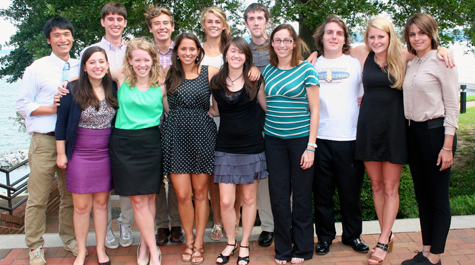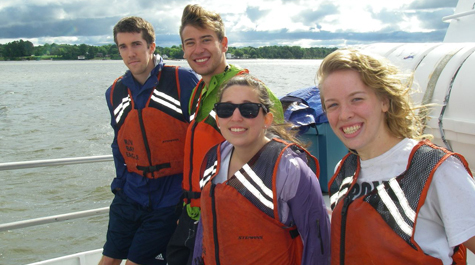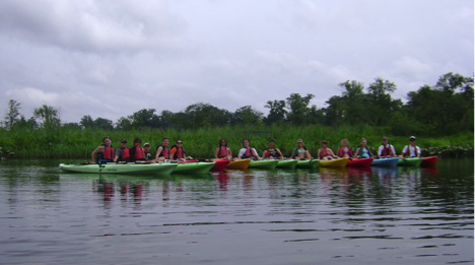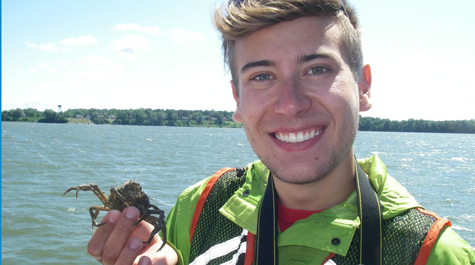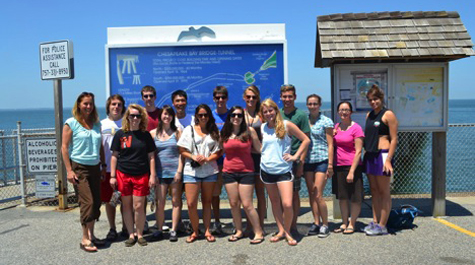Undergraduates complete summer internships at VIMS
Thirteen college and university students from around the nation completed their 10-week-long summer internships at the Virginia Institute of Marine Science in August, showcasing their research projects for an audience of faculty, staff, and students in VIMS’ McHugh Auditorium.
The interns in this year’s “Research Experience for Undergraduates” (REU) program were Mary Chang and Will Sweetser (William & Mary); John DeRosa (University of Georgia); Hannah Ehrmann (Gettysburg College); Marc Hammond (University of Massachusetts Amherst); Nina Jackson (Humboldt State University); Lauren Kelly (Florida Institute of Technology); Chris Lynum (University of Wisconsin); Nichol Parker (Adrian College); Brittany Peachy (Grove City College); Alma Ramirez (Universidad Metropolitana); Caitlin Seppi (University of Maryland); and Martin Wong (John Hopkins University).
Directed by VIMS professors Linda Schaffner and Rochelle Seitz, the program is funded by the National Science Foundation, VIMS, W&M, private donors, and grants to individual faculty.
During the program, each student worked with one or more faculty mentors on an in-depth research project, typically gaining experience in both the field and laboratory. Subjects of the intern’s research ranged from the diversity of denitrifying bacteria in sediments along a salinity gradient in the Pamunkey River to the environmental ecology of a pathogen affecting oysters.
While majority of the students are pursuing degrees at colleges and universities outside Virginia, interns Mary Chang and Will Sweetser opted to spend their summer just a short drive from W&M’s main campus where they are both completing their undergraduate work.
“I applied to the REU program because I’m interested in making marine science my career, and I wanted to gain the valuable research experience it offered,” says Chang. “The program taught me how to effectively gather data, how to organize and present my findings, and about the ins and outs of field research.”
“The VIMS REU program is an important means of offering undergraduate students hands-on research experience in coastal and estuarine science,” says Seitz. “Not only do they conduct their own independent research project, but there are several field trips designed to give them exposure to estuarine and freshwater ecosystems.”
“My favorite part of the program was getting to work with a meld of people who had similar but not identical interests,” says Seppi. “I was able to learn what my fellow interns were working on, and get insight into their research. The program gave me the opportunity to experience research holistically.”
VIMS encourages all students who are interested in marine science—including those traditionally under-represented in the field—to apply for the program. Students can pursue a variety of areas including marine biology and ecology; biological, geological, chemical, and physical oceanography; environmental science; fisheries; and resource management.
“The caliber of our students is very high,” says Seitz. “We have 13 positions to fill, and we pick the cream of the crop from over 200 applicants.”
The program—now in its 24th year—is one of the longest-standing and most successful REU programs in the nation, with more than half of its participants going on to study marine science in graduate school.
2013 REU Student Projects
- Mary Chang: Comparison of West Atlantic Synalpheus shrimp species: Morphology, fecundity, and eusociality. Mentor: Dr. Emmett Duffy.
- John DeRosa: Impacts of Salinity Changes on Denitrification and Anammox in the Pamunkey River Sediments. Mentor: Dr. Bongkeun Song.
- Hannah Ehrmann: Variation in benthic macroinvertebrate community structure and sediment composition in the tidal freshwater sub-tributaries of the York River. Mentors: Jennifer Dreyer, Dr. Linda Schaffner.
- Marc Hammond: The environmental ecology of an oyster parasite: Identifying waterborne stages of Perkinsus marinus. Mentors: Dr. Ryan Carnegie, Nancy Stokes.
- Nina Jackson: A before-after control-impact survey of a living shoreline in Lynnhaven Bay. Mentors: Dr. Rochelle Seitz and Cassandra Glaspie.
- Lauren Kelly: Volume Transport and Properties of Pacific Water along the Chukchi-Beaufort Shelfbreak and through Barrow Canyon. Mentor: Dr. Donglai Gong.
- Chris Lynum: Diversity of denitrifying bacteria in the sediments along a salinity gradient of the Pamunkey River, Virginia Mentor: Dr. Bongkeun Song.
- Nicol Parker: Analysis of the spatial distribution of PAHs in pore-water. Mentor: Dr. Michael Unger.
- Brittany Peachey: Evaluation of cytochalasin B and 6-dimethylaminopurine for tetraploidy induction in the Eastern Oyster. Mentor: Dr. Stan Allen.
- Alma Ramirez: Effects of outwelling on the metabolism of the York River Estuary, VA. Mentor: Dr. Mark Brush.
- Caitlin Seppi: Lethal and sublethal effects of sediment burial on oysters. Mentor: Allison Colden, Dr. Romuald Lipcius.
- Will Sweetser: Osteology of Pholis laeta as a baseline for a comparative analysis for phylogenetic relationships among species of the family Pholidae (Cottiformes: Zoarcoidei) Mentor: Dr. Eric Hilton.
- Martin Wong: The examination of the stock structure of white marlin, Kajikia albida, using microsatellite markers. Mentors: Dr. Jan McDowell, Heidi Brightman.


